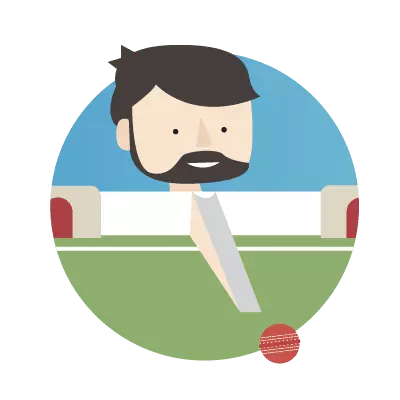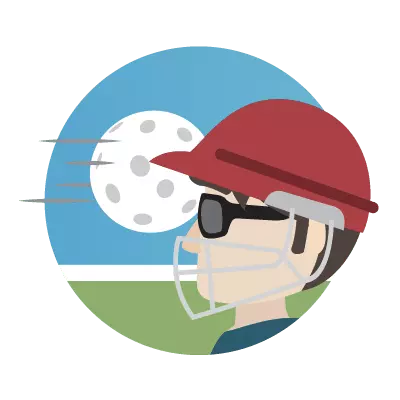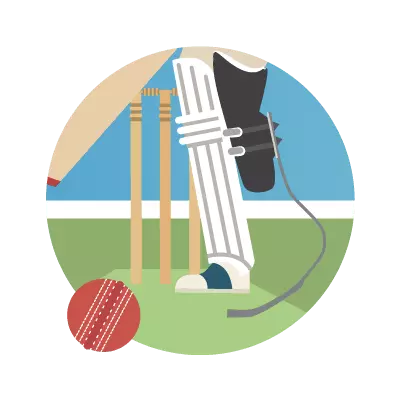How to Get Involved with Disability Cricket
21 June 2017
When it comes to participation in sport, for a lot of us it can be a question of having good intentions but a not so good level of application. The usual impediments can be put down to a lack of time, organisation or money, but if you have a form of disability the barriers to playing sport can be much more difficult to overcome.
However, for any aspiring player wanting to get into disability cricket, there are quite a lot of options (and levels) available…
Disability Cricket Formats
At the highest level, the England and Wales Cricket Board (ECB) have established international teams for the following 4 impairment groups:
- Physical Disability (PD)
- Learning Disability (LD)
- Visually Impaired (VI)
- Deaf
These groupings are predominantly a template for the various levels of the game. But it’s important to note that disability cricket isn’t just about helping to aspire disabled cricketers to fulfil their potential. It’s also about creating ways for as many members of the disabled community as possible, to have fun and enjoy a social activity.
During our research, it has become apparent that there is no comprehensive list available to help aspiring disabled cricketers to reach their local club. With that in mind, this guide aims to provide a resource for discovering the ways that you can enjoy playing disability cricket and where.
Table Cricket
 Table Cricket is a version of cricket that takes place on a table tennis sized table. Initially recommended for children between the ages of 5 and 11, it is now becoming increasingly popular with over 11s and adults too.
Table Cricket is a version of cricket that takes place on a table tennis sized table. Initially recommended for children between the ages of 5 and 11, it is now becoming increasingly popular with over 11s and adults too.
There are 6 people on each team and a starting score of 200, where 5 points are at stake for each dismissal. An innings is limited to 2 overs each and runs scored/getting out depend upon where the ball is hit into the panels around the table perimeter, where sliding fielders lie in wait.
The game was originally designed for young people who have physical or learning disabilities that inhibit them from taking up other forms of cricket. It has grown to the extent that there is now an annual, national championship that culminates at Lord’s itself, following regional competitions.
Adaptive Kwik Cricket
A pretty flexible version of cricket, hence the name, the aim is to create customised games that can suit the participants. You may play in pairs, or adapt a form of cricket that is well suited to deaf/visually impaired people, with plastic bats and balls.
Other Forms of Disability Cricket
Wheelchair Cricket and Walking Cricket are tailored towards people with various physical abilities and severity of disabilities, with the latter being like Walking Football in that it’s popular with the over 50s.
 A newer format, and a work in progress, is Clock Cricket. Designed with older, less mobile people in mind, it is thought that it will be particularly popular within care homes. All the players sit in a circle and, using a special bat, they face 8 (sponge) balls to determine the winner.
A newer format, and a work in progress, is Clock Cricket. Designed with older, less mobile people in mind, it is thought that it will be particularly popular within care homes. All the players sit in a circle and, using a special bat, they face 8 (sponge) balls to determine the winner.
Disabled Cricket Clubs by County & Country
Options exist for whatever level you aspire to play at. Searching for Community Cricket Clubs is a good way to begin participating in the game and County Cricket Clubs (CCC) are increasingly proactive in how they support and provide resources.
There are 18 first-class county cricket clubs and 20 minor counties, all of which have a hand in running disability cricket programmes, usually through their respective Cricket Boards. So, depending on where you live, try getting in touch with one of the following to initiate a conversation on disability cricket. You’ll find dedicated pages and contact information for all, although some of them may require a little extra digging:
County Championship:
Minor Counties Championship:
| |
In late 2013 the ECB established 3 regional disability cricket centres to source potential talent. These were based in the North (Lancashire CCC), Midlands (Northampton CCC) and the South East (Whitgift School).
The centres were originally conceived to cater for all four of the impairment groups (PD, LD, VI and Deaf), however their focus became more upon PD and LD. Talent scouts and a Talent Centre Manager were located at each of them, providing an infrastructure where the best disabled cricketers could be incorporated into an elite programme.
However, as of earlier this year, the centres are sadly no longer operating. But, if you’re confident and believe you can one day represent England, the ECB are currently looking at a new configuration which sounds likely to resemble a ‘Lions’ structure. This could act as a level between club or county cricket, and the full national sides.
When looking at the rest of the United Kingdom, the best places to begin are listed below:
- Cricket Ireland. There are links here to the 5 provincial governing bodies, contact them and ask for local clubs that can provide access to disability cricket.
- Cricket Scotland. Find details here for their Disability Cricket Development Officer.
- Cricket Wales. Plenty of contacts here that can provide opportunities for playing the game.
Disability Sport England
Statistics are unavailable for Wales, Scotland and Northern Ireland, but the most recent figures from the English Federation of Disability Sport (EFDS) states that “16.8 per cent of disabled people take part in sport for 30 minutes once a week, compared to 39.9 per cent of non-disabled people”.
This is clearly a problem, and the issues that have been most commonly identified as preventing a greater level of participation in disability sport, tend to be categorised within the following 3 areas:
- Physical
- Logistical
- Psychological
The physical concerns relate to a failure to make the necessary adaptations and changes needed to support participation. Whereas the logistical concerns are to do with said adaptations being ineffective.
However, what is classed as the clearest barrier to participation in disability sport, is the psychological side of things. This can be due to the would-be participant lacking confidence or awareness, as well as non-disabled people not having the awareness of what they can do to assist.
In recent years, there have been proactive efforts made to lessen the impact of these obstructions. However, progress can be incrementally slow and some sports are more advanced than others, and one of these is cricket.
Disability Cricket Development
 At the national level, England made a major announcement in May 2017 when, for the 1st time, they appointed 2 full-time coaches for their disability teams. Ian Salisbury, who played 15 tests for England between 1992 and 2001, is the new head coach for the England Physical Disability team. Whilst Ross Hunter is now able to fully commit to his position as the head coach for the England Visually Impaired team.
At the national level, England made a major announcement in May 2017 when, for the 1st time, they appointed 2 full-time coaches for their disability teams. Ian Salisbury, who played 15 tests for England between 1992 and 2001, is the new head coach for the England Physical Disability team. Whilst Ross Hunter is now able to fully commit to his position as the head coach for the England Visually Impaired team.
The professional side of the sport is on the rise, and the infrastructures in place for disability cricket are clearly improving and being taken more seriously. Opportunities are therefore expanding, but what remains is the need to overcome the psychological hurdles and this will be an ongoing process.
This is especially so when it comes to the ‘grassroots’ of the sport, where there is still a tremendous reliance upon the voluntary sector, and indeed this is how disability cricket came into being roughly 30 years ago.
A lot has been made of the necessity for County Cricket Boards to understand how volunteers are key to keeping this version of the game blossoming. There is also a great deal to be said about the significance of understanding the disabled community and in building national and local partnerships.
Without these the outreach and development of disability cricket will be undermined, and the reassurances that some people with disabilities need won’t be forthcoming.
Ultimately a lot of this is about developing an improved empathy and appreciation for the challenges that face the people who want to partake in disability cricket. Aspects of the mainstream version of cricket may not always apply to their various counterparts in disability cricket. This may sound like a case of stating the obvious, but then you’d be surprised at how often these issues can be assumed or ignored.
As with many other institutions and sports, the ECB have established their own DIT (Disability Inclusion Training) course to aid and assist coaches. For example, there may be a misconception that people with disabilities only want to play disability cricket. However, depending on the level of their impairment, if a disabled person feels that they can enjoy the experience of playing mainstream cricket, then they are often more inclined to seek that option.
Ultimately the ECB have done well in making disability cricket increasingly prevalent and, alongside Sport England, they promise to continue to provide funding for the future.
Play Disability Cricket
 If the thought of disability cricket appeals to you, then get involved today. It doesn’t matter what you’re looking for, the possibilities are there to be had.
If the thought of disability cricket appeals to you, then get involved today. It doesn’t matter what you’re looking for, the possibilities are there to be had.
To start your search, the official advice is that you should email disabilitycricket@ecb.co.uk, or alternatively contact your local County Cricket Board and they will be able to assist you.
For those who are interested in participating in Deaf Cricket, the go to source for this is the England Cricket Association for the Deaf (ECAD). The only qualification you need is that you wear hearing aids or Cochlear implants, and there are established clubs in Lancashire, Nottinghamshire, Surrey and Yorkshire.
As for the Visually Impaired version of the game, Blind Cricket England & Wales (BCEW) are the organisation that maintains its ongoing functionality, alongside British Blind Sport (BBS). Between them there is a domestic cup competition and a ‘national’ league, and their website has plenty of useful information.
Finally, according to the ECB, there are 34 teams competing in PD/LD county competitions, these are divided between Super 9’s Cricket (softball), and the D40 League (hardball). The British Association for Cricketers with Disabilities (BACD) are a helpful source for regional competitions, and they can also provide details on the different eligibility criteria. At present, the online presence of individual clubs can be a bit limited, but some of them are listed below:
- Derbyshire Disabled CC
- Essex Disabled CC
- Gloucestershire Disabled CC
- Hampshire Disabled CC
- Isle of Wight
- Kent Disabled CC
- Lancashire Disabled CC
- Middlesex Disabled CC
- Shropshire Disabled CC
- Somerset Disabled CC
- Sussex Disabled CC
Useful Links:
National Disability Sports Organisations (NDSOs):
https://www.britishblindsport.org.uk/
Sources:
https://cfpd.org.uk/contacts/clubs/
https://www.disabilitysportwales.com/
https://www.scottishdisabilitysport.com/
https://www.lordstaverners.org/